
Allium validum is a species of flowering plant commonly called swamp onion, wild onion, Pacific onion, or Pacific mountain onion. It is native to the Cascade Range, to the Sierra Nevada, the Rocky Mountains, and other high-elevation regions in California, Oregon, Washington, Nevada, Idaho and British Columbia. It is a perennial herb and grows in swampy meadows at medium and high elevations.
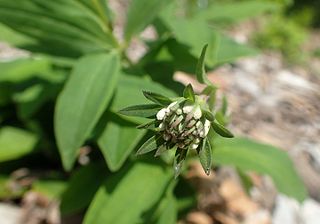
Marshallia is a genus of plants in the tribe Helenieae within the family Asteraceae. Marshallia is native to the southeastern and south-central United States. A common name applied to most species in the genus is Barbara's buttons.

Paronychia is a genus of plants in the family Caryophyllaceae with over 110 species worldwide, mostly from warm-temperate North America, Eurasia, South America and Africa. They are herbs that are annual or biennial or perennial in life span. Some species have a woody base. For the most part they have small, white to yellow-white colored flowers that are often hidden within the paired bracts.

Symphyotrichum lateriflorum is a species of flowering plant in the aster family (Asteraceae). Commonly known as calico aster, starved aster, and white woodland aster, it is native to eastern and central North America. It is a perennial and herbaceous plant that may reach heights up to 120 centimeters and widths up to 30 cm (1 ft).

Tofieldia is a small genus of flowering plants described as a genus in 1778. It is widespread across much of Europe, Asia, and North America.
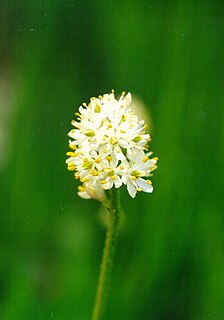
Triantha is a small genus of flowering plants in the family Tofieldiaceae, first described as a genus in 1879. False asphodel is a common name for plants in this genus.
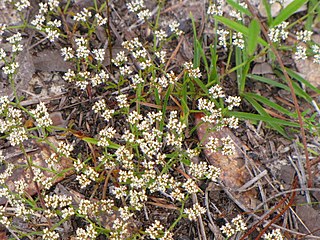
Paronychia rugelii, common name Rugel's nailwort, is a plant native to the US states of Georgia and Florida. It can be found in woodlands and on disturbed sites at elevations below 200 m. They are sometimes referred to as sand squares.
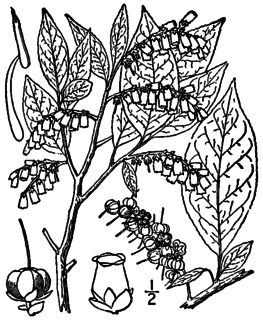
Eubotrys recurva is a plant species native to the eastern United States. Common names include deciduous mountain fetterbush and red-twig doghobble.
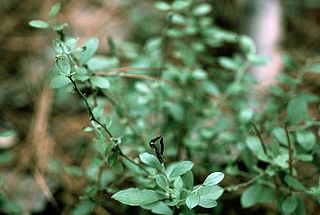
Vaccinium tenellum, the small black blueberry is a plant species native to the southeastern United States from southeastern Mississippi to northern Florida to southern Virginia. It grows in forests and in shrubby areas at elevations up to 200 m.

Sagittaria platyphylla, the delta arrowhead, broad-leaf arrowhead or delta duck-potato, is a plant species native to the eastern United States. The core of its range extends from central Texas to the Florida Panhandle north to southern Illinois.
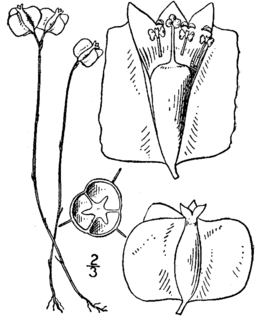
Burmannia biflora, common name northern bluethread, is a plant species native to Cuba, the Bahamas and to the southeastern United States. It has been reported from Puerto Rico, eastern Texas, Louisiana, southwestern Arkansas, southern Mississippi, southern Alabama, Florida, Georgia, South Carolina, North Carolina and southeastern Virginia.

Aletris farinosa, called the unicorn root, true unicorn, crow-corn, white colic-root or white stargrass, is a plant species found across much of the eastern United States. It has also been reported from the southern part of Ontario, Canada. It is known from every state east of the Mississippi River except Vermont, as well as Texas, Oklahoma, Arkansas and Louisiana.

Allium macropetalum, the desert onion, is a species of wild onion native to the desert regions of southwestern United States and northwestern Mexico. It is known from desert plains and hills in Sonora, Arizona, Utah, Colorado, New Mexico, and Texas, at elevations up to 2500 m.
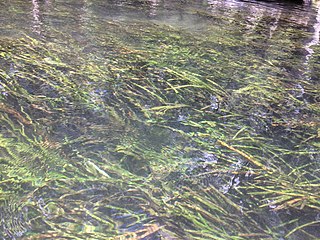
Sagittaria kurziana, common names springtape and strap-leaf sagittaria, is an aquatic plant species native to Florida and naturalized in the Mariana Islands. It grows along large springs, very often those with high sulfur content, and along the banks of watercourses downstream from such springs.

Styrax grandifolius, the bigleaf snowbell or bigleaf storax, is a plant species native to the southeastern United States, ranging from Virginia south to Florida and west to Texas and Missouri. The plant grows as a deciduous shrub or tree up to 6 metres (20 ft) high, and is most commonly found in upland forests of the southeast's piedmont. As the specific epithet suggests, the species has larger leaves than sympatric Styracaceae, with alternate, obovate leaves up to 14 cm long and 10 cm wide that are densely pubescent underneath. Flowers are borne during early summer in racemes containing up to 20 flowers.
Lactuca graminifolia, the grassleaf lettuce is a North American species of wild lettuce. It grows in Mexico, Central America, Hispaniola, and the southern United States from Arizona to Florida, Virginia and the Carolinas.
Krigia montana, known as mountain dwarfdandelion, is a North American species of plants in the family Asteraceae. It is native to the Great Smoky Mountains and other nearby peaks in the southern Appalachians of Tennessee, the Carolinas, and Georgia. It is found on cliffs and outcrops at high elevations.
Krigia occidentalis, known as western dwarfdandelion, is a North American species of plants in the family Asteraceae. It is native to the southern Great Plains and the Ozark Mountains of the south-central United States.

Sesuvium maritimum is an annual herbaceous plant native to southeastern North America in the family Aizoaceae. This species is commonly known as the annual or slender sea purslane. It can be found on sandy beaches, salt marshes, or other coastal regions.















